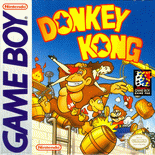
































Donkey Kong

Donkey Kong is a platform game developed in 1994 by Nintendo for the Game Boy handheld video game system, which also contains puzzle elements. Donkey Kong is loosely based on the 1981 arcade game of the same name and its sequel Donkey Kong Jr. The game was known under the working title Donkey Kong '94 before the release. Like in the original arcade and NES version, the player takes control of Mario and must rescue Pauline from Donkey Kong (who are both given updated character designs for this game). Donkey Kong Jr. makes a guest appearance in the game on some levels, helping his father hinder Mario's progress.
This was the first Game Boy title designed with enhanced features when played on the Super Game Boy. It features gameplay elements from Donkey Kong, Donkey Kong Jr., and Super Mario Bros. 2.
Donkey Kong begins with the four levels found in the original arcade game, in which Mario must reach the top of the level and save Pauline. After these four initial stages are completed, the usual arcade ending begins, but after a few notes of the 'victory theme' Donkey Kong revives, grabs Pauline again, and takes off with her, with Mario giving chase. The player is then presented with 97 additional stages spanning nine worlds, for a total of 101 stages with the very last one a fight against a mutated, larger Donkey Kong.
The subsequent levels follow a completely different game mechanic in which the player must guide Mario through each level to locate a key. He must pick it up and carry it to a locked door elsewhere in the stage. Every fourth level is a 'battle level' in which the player must either try to reach Pauline, like in the original levels, or defeat Donkey Kong by using his own barrels against him. After the fourth level is cleared, a short cutscene is shown depicting a player's abilities that may be needed for the upcoming levels, or to introduce new kinds of traps. At this point, players are allowed to save their progress, including their time for each level or for the total set. Extra lives can be earned via mini-games, unlocked by collecting three special items in each level, or at the end of each set based on the total unused time from that set.
The game features various gameplay enhancements from the original game. Mario is able to survive falling from certain distances, though will lose a life if he falls further. Mario will also lose a life if he hits an enemy or obstacle, though some instances allow Mario to withstand the hit, such as being hit while carrying an item. Similar to Super Mario Bros. 2, he is able to pick up and throw items or certain enemies, which he will need to use to carry the key over to the door. If the key is left alone for a certain amount of time, it will return to its original place. At any point, Mario can flip over onto his hands, which allows him to catch falling barrels, and can also perform higher jumps by timing his jumps from flipping, or by performing a jump while changing direction.
The classic mallet item can be thrown upwards and can be used again if Mario catches it, allowing him to bring it to different parts of the stage. There are also several blocks that allow the player to add bridges, ladders and springs anywhere on the screen for a short amount of time. Other abilities Mario can perform include swimming, climbing ropes in a similar fashion to Donkey Kong Jr. and spinning on wires to reach new heights.
How to play:
Click on the joystick icon in the Donkey Kong online emulator to see how to control the Donkey Kong game






































Comments